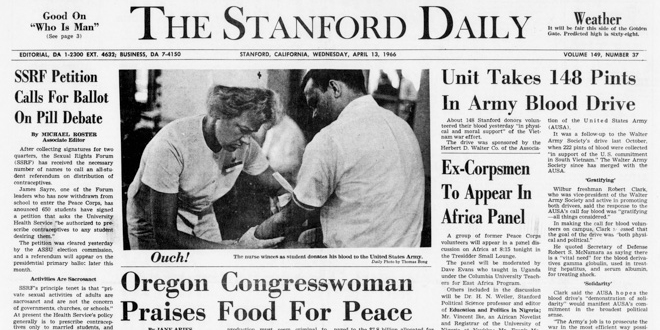The feature “On this day in Stanford history” details events that occurred on the same date in past years at Stanford.
According to The Stanford Daily’s archives, on April 13 in …
1897: Thomas Welton Stanford, brother of University founder Leland Stanford, donated a collection of fifty paintings to the Stanford museum. They depicted Australia, where the Melbourne-based Thomas Stanford lived.
1920: The Student Council threatened to abolish “roughing” at the Women’s Clubhouse following multiple complaints about “the increased breaking of windows and damage caused … [at] recent dances.”
1936: The Daily announced the commencement of a ping pong tournament, noting that admission was 25 cents.
1942: The American military base Corregidor Island in Manila Bay held out against twelve rounds of bombing and artillery strikes by Japanese forces, the Daily reported.
1954: The New York Times broke the story that Dr. J. Robert Oppenheimer — the so-called “father of the atomic bomb” — had been suspended pending a review of his security record.
1955: The discovery of a polio vaccine “set into motion long-made plans for vaccinating 57,000,000 children before summer’s end,” The Daily reported.
1961: Yuri Gagarin returned to Earth after becoming the first man in space. “Russia Goes Wild,” The Daily headline noted.
1966: The Daily reported that the Sexual Rights Forum (SSRF) had gained enough petition signatures to call a campus-wide referendum on whether the University health program should start distributing contraceptives to students. The policy at the time was that contraceptives were only provided for married or engaged students, which SSRF co-leader James Sayre called “a moral judgement on non-marital intercourse.”
1971: Six policemen used a search warrant to enter and search The Daily building, seeking photographic evidence to use in prosecutions related to a recent sit-in that had turned violent. The officers left empty-handed, and editor Felicity Barringer ’72 responded to the incident by saying that “it is extremely difficult for any news organization to perform its function in a democratic society if it is working under the constant threat of governmental subpoena or a government-sanctioned search of its confidential files.” The incident evolved into a Supreme Court case, Zurcher v. Stanford Daily.
1978: The Central Intelligence Agency (CIA) conducted “extensive monitoring” of “radical political groups” at Stanford and at least 57 other colleges from 1967 until 1973, The Daily reported in the wake of the declassification of documents concerning “Project Resistance.”
1993: After investigations failed to show any concrete proof of cheating, The Daily reported that the finals for Philosophy 58 and Geophysics 4 would count, despite numerous allegations of academic dishonesty.
2012: The Daily reported on a series of criticisms made about ASSU Vice President and Executive candidate Stewart MacGregor-Dennis ’13 after it emerged that he had spent over $2,000 on various online services as part of his election campaign.
Contact Brian Contreras at brianc42 ‘at’ stanford.edu.
